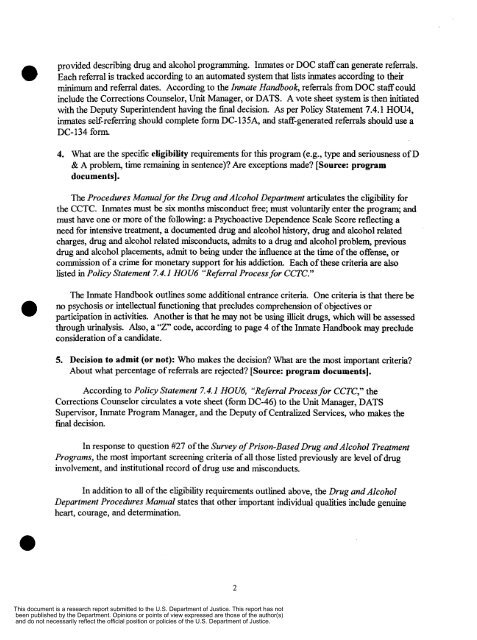0 - National Criminal Justice Reference Service
0 - National Criminal Justice Reference Service
0 - National Criminal Justice Reference Service
You also want an ePaper? Increase the reach of your titles
YUMPU automatically turns print PDFs into web optimized ePapers that Google loves.
@<br />
provided describing drug and alcohol programming. Inmates or DOC staff can generate referrals.<br />
Each referral is tracked according to an automated system that lists inmates according to their<br />
minimum and referral dates. According to the Inmate Handbook, referrals fiom DOC staff could<br />
include the Corrections Counselor, Unit Manager, or DATS. A vote sheet system k then initiated<br />
with the Deputy Superintendent having the final decision. As per Policy Statement 7.4.1 HOU4,<br />
inmates self-referring should complete form DC-l35A, and staff-generated referrals should use a<br />
DC- 134 form.<br />
4. What are the specific eligibility requirements for this program (e.g., type and seriousness of D<br />
& A problem, the remaining in sentence)? Are exceptions made? [Source: program<br />
documents].<br />
The Procedures Manual for the Drug and Alcohol Department articulates the eligibility for<br />
the CCTC. Inmates must be six months misconduct fiee; must voluntarily enter the program; and<br />
must have one or more of the following: a Psychoactive Dependence Scale Score reflecting a<br />
need for intensive treatment, a documented drug and alcohol history, drug and alcohol related<br />
charges, drug and alcohol related misconducts, admits to a drug and alcohol problem, previous<br />
drug and alcohol placements, admit to being under the influence at the time of the offense, or<br />
commission of a crime for monetary support for his addiction. Each of these criteria are also<br />
listed in Policy Statement 7.4.1 HOU6 “Referral Process for CCTC.”<br />
The Inmate Handbook outlines some additional entrance criteria. One criteria is that there be<br />
no psychosis or intellectual hctioning that precludes comprehension of objectives or<br />
participation in activities. Another is that he may not be using illicit drugs, which will be assessed<br />
through urinalysis. Also, a “Z” code, according to page 4 of the Inmate Handbook may preclude<br />
consideration of a candidate.<br />
5. Decision to admit (or not): Who makes the decision? What are the most important criteria?<br />
About what percentage of referrals are rejected? [Source: program documents].<br />
According to Policy Statement 7.4.1 HOU6, “Referral Process for CCTC,” the<br />
Corrections Counselor circulates a vote sheet (form DC-46) to the Unit Manager, DATS<br />
Supervisor, Inmate Program Manager, and the Deputy of Centralized <strong>Service</strong>s, who makes the<br />
final decision.<br />
In response to question #27 of the Survey of Prison-Based Drug and Alcohol Treatment<br />
Programs, the most important screening criteria of all those listed previously are level of drug<br />
involvement, and institutional record of drug use and misconducts.<br />
In addition to all of the eligibility requirements outlined above, the Drug and Alcohol<br />
Department Procedures Manual states that other important individual qualities include genuine<br />
heart, courage, and determination.<br />
2<br />
This document is a research report submitted to the U.S. Department of <strong>Justice</strong>. This report has not<br />
been published by the Department. Opinions or points of view expressed are those of the author(s)<br />
and do not necessarily reflect the official position or policies of the U.S. Department of <strong>Justice</strong>.
















